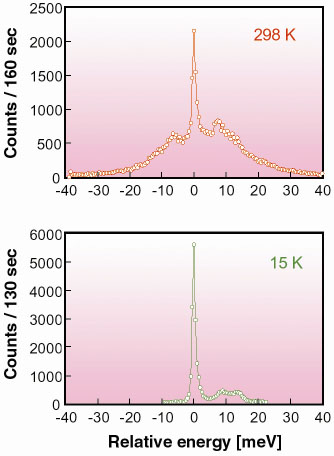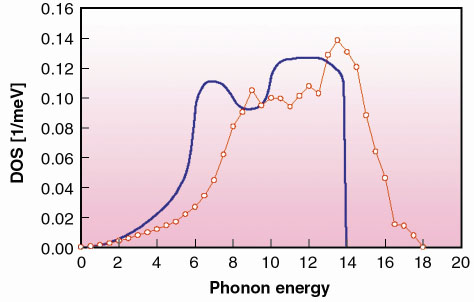- Home
- Users & Science
- Scientific Documentation
- ESRF Highlights
- ESRF Highlights 2001
- Collective Atom Dynamics
- Nuclear Inelastic Scattering with 161Dy
Nuclear Inelastic Scattering with 161Dy
Nuclear inelastic scattering (NIS) is an isotope-specific technique (and consequently element-specific), which allows one to determine the phonon density of states (DOS) of atoms that possess a nuclear resonant level. The technique is fast, precise, requires only a small amount of material, and can be applied to samples in various aggregate states [1]. Since the start of its development in 1995, the majority of studies were performed on systems that contain the "classical" 57Fe isotope. Later the technique was extended to the 119Sn and 151Eu isotopes. Here we report on a first application of nuclear inelastic scattering to 161Dy. This development was motivated by the role of dysprosium in various fields of research. For instance, Dy is a constituent atom of several high-temperature superconducting materials, and NIS studies may give new insights into their lattice dynamics and thermodynamics. Furthermore, several Dy compounds have interesting magnetic properties, where NIS could help clarifying the influence of magneto-acoustic interactions on the lattice dynamics. Finally, Dy forms stable complexes with fullerenes, which are model objects for rotational dynamics studies.
We have elaborated a high energy-resolution monochromator for the 25.651 keV radiation of 161Dy with an energy bandpass of 1 meV providing 5.7 x 106 photons per second at 90 mA current in the storage ring. The monochromator consists of two ''nested" channel-cut crystals. For the outer channel-cut crystal, an asymmetric Si(4 4 4) reflection was chosen with an asymmetry factor of 0.10. For the inner channel-cut crystal, a symmetric Si(18 12 6) reflection was used.
The experiment was performed at the nuclear resonance end-station ID22N. The sample was a 50 µm thick foil of Dy metal with a 95.7% abundance of the resonant 161Dy isotope. The energy dependence of the nuclear inelastic absorption is shown in Figure 81. It gives the probability of nuclear inelastic absorption as a function of energy, obtained from the lattice due to phonon annihilation (E < 0), or transferred to the lattice for phonon creation (E > 0). At room temperature, the energy spectrum is dominated by multi-phonon contributions, while at 15 K the spectrum consists mostly of single-phonon absorption with only a small contribution of multi-phonon components.
 |
Fig. 81: Energy dependence of inelastic nuclear absorption of synchrotron radiation in a 161Dy metal foil at room temperature and at 15K. |
From the data at 15 K we derived the phonon DOS (Figure 82, open circles). These are compared to the phonon DOS at room temperature from ref. [2], where the dynamics of dysprosium was evaluated by an interpolation of data of the elastic constants from terbium and holmium. Our measurements give approximately a factor of two smaller amount of phonon states in the soft part (E < 8 meV) of the spectrum. This difference may be explained by the damping of lattice vibrations at higher temperatures.
 |
Fig. 82: Phonon density of states for Dy metal: open circles and thin line (guide to the eye) show the phonon DOS as derived from the energy spectrum of nuclear inelastic absorption measured at 15K. The solid line shows the results of theoretical calculations for room temperature [2]. |
In summary, we have demonstrated the feasibility of nuclear inelastic scattering for the 25.651 keV nuclear transition of 161Dy. Applications making use of this technique for 161Dy can now be envisaged. Furthermore, by combining nuclear inelastic scattering with nuclear forward scattering, magnetic and electronic properties may be probed simultaneously with the lattice dynamics.
References
[1] A.I. Chumakov and W. Sturhahn, Hyp. Interact., 123/124, 781 (1999).
[2] R.R. Rao and C.S. Menon, J. Phys. Chem. Solids, 34, 1879 (1973).
Principal Publication and Authors
A.I. Chumakov (a), R. Rüffer (a), O. Leupold (a), A. Barla (a), H. Thiess (a), N.A. De Campos (b), H.V. Alberto (b), J. Gil (b), R. Vilao (b) and V.G. Kohn (c), Phys. Rev. B, 63, 172301 (2001).
(a) ESRF
(b) Department of Physics, University Coimbra (Portugal)
(c) Russian Research Center ''Kurchatov Institute'', Moscow (Russia)



